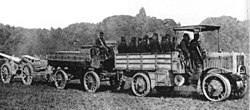Arthur Constantin Krebs
This articleneeds additional citations forverification.(January 2013) |






Arthur Constantin Krebs(16 November 1850 inVesoul,France – 22 March 1935 inQuimperlé,France) was a French officer and pioneer in automotive engineering.
Life
[edit]Collaborating withCharles Renard,Krebs pilotedthe first fully controlled free-flightmade in the French ArmyairshipLa France,which was designed in 1884. The flight[1]covered 8 km (5.0 mi) in 23 minutes. The flight landed back at its starting point.[2]On its seven flights theLa Francedirigible returned five times to its starting point.
Krebs and Renard shared the 1886 Ponti prize of the FrenchAcadémie des sciencesfor their contribution toaerostation.
Krebs inspiredJules Verne.In Verne's 1886 novelRobur The Conqueror,he writes of "the striking experiments of Captain Krebs and Captain Renard".
In 1888 Krebs andGustave Zédédesigned the first modern French submarine, theGymnote.The submarine was fitted with the first navalperiscopeand the first naval electricgyrocompass.The latter allowed theGymnoteto force a naval block in 1890.
From 1884 to 1897 Arthur Krebs modernized theVille de Parisfire department; not only its equipment but its organisation as well. His work left a lasting impression in this elite corps.
In May 1896 Arthur Krebs patented a new automobile, fitted with an electromagneticgearboxand a layout of the front wheels which re-centred them when the steering wheel was left alone. Today this is known as theCastor angle.ThePanhard et Levassorcompany acquired a license to build 500 cars under the name ofClement-Panhardbetween 1898 and 1902 featuring this innovation.
Krebs succeeded Levassor as Panhard et Levassor's general manager from 1897 to 1916. He transformed the Panhard et Levassor Company into one of the largest and most profitable automobile manufacturers before World War I.
In 1898 Krebs replaced the tiller with an inclinedsteering wheelfor the Panhard et Levassor car he designed for the Paris-Amsterdam race which ran from the 7 to 13 July 1898. Fernand Charron won that race on a four cylinder Panhard et Levassor. At the end of 1898, C S Rolls introduced the first car in Britain fitted with wheel steering[3]when he imported a 6 hp Panhard et Levassor from France.
In 1902 Krebs invented the automatic diaphragm carburettor which gave cars continuous power during acceleration by providing a constant air-fuel ratio at all times; this also led to dramatic improvement in fuel economy.
In 1906 Krebs traveled to the United States to plead in theSelden Case,associated withHenry Ford.


Krebs introduced many improvements in car design: the steering wheel (1898), non-reversible steering (1898), engine balance (1898), nickel steel alloys and other special steel alloys (1901), the shock absorber (1906), multi-disc clutch (1907), the electric brake dynamometer for testing high performance engines (1905), the enveloping (globoid)worm geardifferential(1915).
Also, Krebs contributed significantly to improve theSysteme Panhard(engine in front, rear wheel drive) which became universally adopted before World War II.
In 1909, he became interested in the Knight patent (sleeve valveengine) and was first in France to build that type of engine which Panhard et Levassor would produce during the thirty years leading up to World War II.
He made contributions to automotive racing with his powerful cars and motorboats.
In 1911 Krebs invented the first elastomericflexible coupling(cf. John Piotrowski). It is known in French as theFlectorjoint. This device is still widely used today in industry for power transmission as atyre coupling.
The truck was meant for military and civil purposes. In 1911, jointly with the Chatillon Co, Krebs designed theTracteur Chatillon-Panhardall-terrain truck. The truck had four wheel drive and four wheel steering and many were used during World War I as artillery tractors.
Krebs also utilized his former military membership to supply the French Army with engines and vehicles including the 1904 GentyArmored car,the1916 St Chamond tank,the Chatillon-Panhard 4x4 truck, and others.
In 1960, the United Kingdom Antarctic Place-Names Committee (UK-APC) namedKrebs Glacier,a glacier flowing west into the head of Charlotte Bay on the west coast of Graham Land in the Antarctic continent, after Krebs.
Papers presented to the FrenchAcadémie des sciences
[edit]- 18 August 1884 – Krebs and Renard: About the "La France" Dirigible.
- 11/10/1884 – Krebs and Renard: The "La France" Dirigible.
- 1888 – Krebs: Closed Magnetic Field system of the Telephone.
- 1888 – Krebs: Electric Engine Trials for a Submarine Boat.
- 1890 – Krebs: The First ElectricGyrocompass(presented par M. Dumoulin-Froment)
- 24 November 1902 – Krebs: The AutomaticCarburettor.
- 13 November 1905 – Krebs: The Electric Dynamometric Brake.
- 15 January 1906 – Krebs: The Progressive Shock Absorber.
- 04/08/1907 – Krebs: The liquid flow measurement apparatus.
In 1934, several months before Arthur Krebs's death, he was made a Commandeur of theLegion of Honorfor his work in Aeronautics and for his contributions to the automotive industry.
See also
[edit]- Arthur Constantin KREBS: Main articleonWikiversity
- Airship
- Blimp
- Charles Renard
- Pierre Jules César Janssen
- Timeline of aviation - 19th century
- Panhard et Levassor
- The 1916 St Chamond tank
- Timeline of hydrogen technologies
References
[edit]External links
[edit]- Works by or about Arthur Constantin KrebsatInternet Archive
- Charles Renard and Arthur Krebs in theUS Centennial of Flight Commission
- The site dedicated to Arthur KREBS (in English)
- Clement-Panhard on the Web
- Hydroplane History:The Development of the High-Speed Launch or Automobile Boat – 1904
- Jules Verne:Robur The Conqueror
